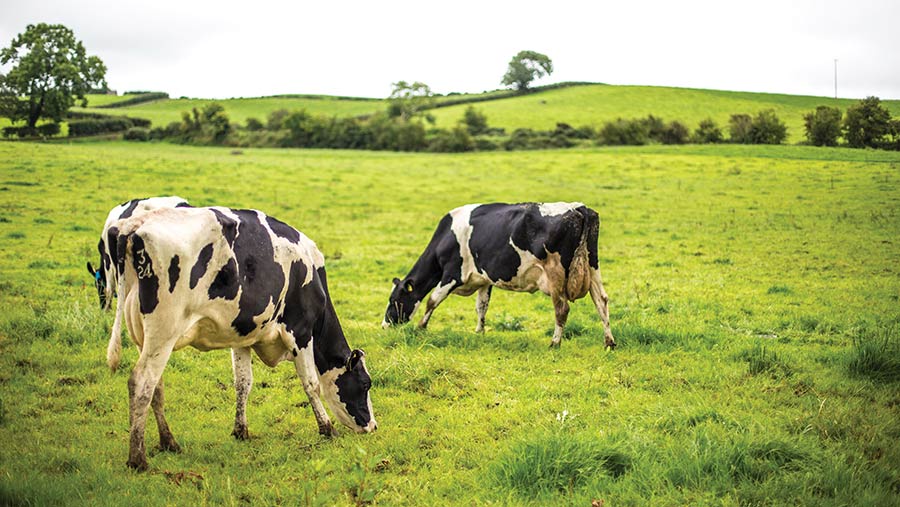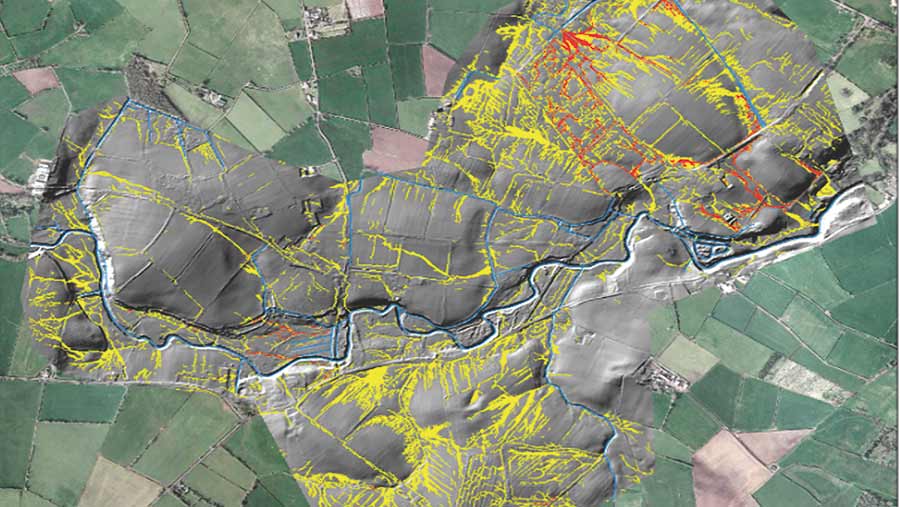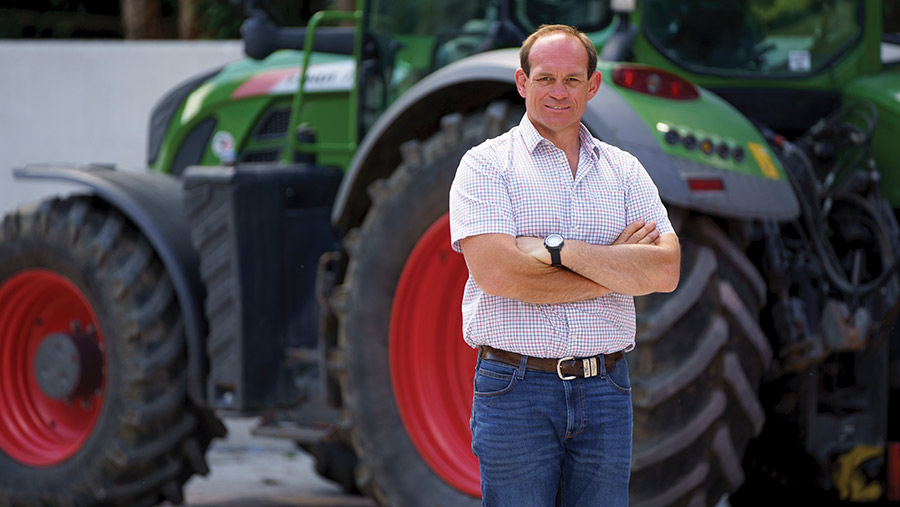Project shows how farming can hit – or better – net zero
 © Fabiano/Adobe Stock
© Fabiano/Adobe Stock A pioneering carbon project in Northern Ireland has demonstrated that farms can make structured progress towards net zero and revealed that some are already hitting the target.
Under NI’s Climate Change Act (2022), businesses must cut emissions by 48% before 2030 and make a 100% reduction, or reach net zero, by 2050.
Agriculture in NI is key to those targets as the largest contributor to its greenhouse gas (GHG) emissions, accounting for about 27% of the total output.
Because of this figure, NI farmers have been a major focus for policymakers, campaigners and the media.
See also: 4 popular carbon calculators for farms compared
However, these groups have persistently overlooked the fact that, unlike other sectors, agriculture has a capacity to capture, manage and store carbon.
Carbon stocks
And that is where the Accelerating Ruminant Carbon Zero – or ARC Zero – project comes in.
It aims to show that the focus on emissions alone does not paint an accurate or fair picture of the farming sector, which can go well beyond offsetting its own emissions.
The project was set up by Professor John Gilliland of Queen’s University Belfast, a drystock farmer, former Ulster Farmers’ Union president and environment adviser to the AHDB.
John wanted to respond to the criticisms that have been made without science-based evidence.
He says: “Farming is being short-changed in the environmental debate, with no recognition of our ability to manage carbon. Too much of this debate is about emotion and not about data.
“Everyone talks about gross carbon emissions but won’t talk about sequestration. Farming builds carbon stocks as well as creating emissions, so we felt it was being unfairly treated.”
Since the project began an initial phase in April 2021, the data produced has revealed that farmers manage huge carbon stocks totalling tens of thousands of tonnes stored in soil, pasture, crops, trees and livestock.
Importantly, it has shown that net zero is achievable within the target timeframes and demonstrated how farmers can both cut emissions and increase their carbon storage.
“I can now demonstrate to any detractors that I successfully manage 24,400t of carbon on my own farm,” says John.
“I can face farming’s critics and ask, ‘can you do that?’ I can also say, ‘you need me in the push towards net zero’.
“Farmers are down and confused about managing carbon and how to reach net zero. But there is a way forward, so it is time to lift our heads, get on the front foot and prove to the public and governments that we can deliver net zero,” he insists.
Ahead of the project start date in 2021 John recruited six other farmers across a range of farming types. “We set out to amass the highest degree of quality data so that nobody could question our credibility,” he says.
ARC Zero farmers
- John Gilliland Drystock and coppice willow
- Hugh Harbison Dairy
- Simon Best Arable and beef
- John Egerton Suckler beef and sheep
- Patrick Casement Suckler beef and sheep
- Ian McClelland Dairy
- Roger and Hilary Bell Sheep and beef
The target was to work out a figure for greenhouse gas (GHG) emissions set against carbon sequestration, to get a net farming position. The first stage after recruitment was to establish a baseline for carbon stocks.
This was achieved by:
- Auditing emissions from the farms
- Detailed soil sampling and analysis
- Using detailed aerial scanning via Lidar (see “What is Lidar”, below).
What is Lidar?
Light Detection And Ranging (Lidar) is a remote sensing technology which uses the light from a laser to collect measurements. These are used to create highly detailed 3D images of objects and maps that are more accurate and revealing than satellite scans.
Auditing
Auditing began in April 2021 using SAC’s AgreCalc tool. The process was comprehensive and exhaustive, with data captured on stock numbers, ages, animal production performance, feed use, and buying and selling.
Also factored in were fuel and fertiliser use, including applications, utilisation of animal manures, fodder conservation and electricity consumption.
Soil analysis
Farms were divided into 2ha blocks, including woodland, with each site recorded on GPS. Core samples were taken at 25 points in each block, to a depth of 7.5cm in grassland and 15cm in arable fields. Samples were then analysed for:
- pH
- Phosphate
- Potassium
- Calcium
- Magnesium
- Soil organic matter.
Further soil sampling took place at greater depths, cross-referenced to previous management of those fields to measure carbon stocks.
The project used Agricarbon, a dedicated soil sampling company that operates across the UK, EU and parts of North America. It was introduced to take deeper soil samples at levels to 1m, or as far as the rock below would allow.
The analysis accurately measured soil carbon percentage and fine bulk density at 0-15cm, 15-30cm, 30-60cm and 60-100cm to give totals of carbon that would otherwise have been unaccounted for.
Agricarbon’s involvement also lent greater robustness to the process because of its recognised laboratory analysis procedure.
Above-ground carbon
Above-ground carbon levels were also measured in trees and hedgerows.
This was carried out by BlueSky International using aircraft-mounted Lidar to form a 3D image from 40 scans a metre.
The scans build up a precise 3D picture of trees, hedgerows, pasture and cropping which would otherwise be impossible as satellites cannot deliver this resolution.

A Lidar image of farmland with features highlighted © AFBI
Carbon levels were then calculated by Agrifood and Biosciences Unit Northern Ireland (AFBI) via a system initially trialled by Teagasc and ratified by Ireland’s Environmental Protection agency.
Across the seven farms the results revealed a carbon store of more than 515,000t, in soil and above ground.
“This is a huge stock. Once we knew forensically, for the first time, the extent of what we were holding, we could manage it to keep it locked up or add to it, for the repeat measurement in five years’ time,” says John.
Carbon stocks 2021 on ARC Zero project farms 2021 (tonnes CO2e) |
||
| Farmer | Soil carbon | Above-ground carbon |
| Ian McClelland | 31,813 | 1,310 |
| Hugh Harbison | 68,054 | 1,969 |
| John Egerton | 31,813 | 1,310 |
| Roger & Hilary Bell | 50,819 | 688 |
| Simon Best | 237,915 | 6,493 |
| Patrick Casement | 54,556 | 4,022 |
| John Gilliland | 19,468 | 4,937 |
| Total | 494,438 | 20,729 |
| Combined total | 515,167 | |
Emissions on ARC Zero project farms 2021 (tonnes CO2e/year) |
||||
| Farmer |
Gross emissions |
Gross sequestration |
Net emissions |
Reduction (%) |
| Ian McClelland | 1,101 | 309 | 792 | 28 |
| Hugh Harbison | 2,009 | 549 | 1,459 | 27 |
| John Egerton | 1,475 | 444 | 1,031 | 30 |
| Roger & Hilary Bell | 754 | 456 | 298 | 60 |
| Simon Best | 1,799 | 738 | 1,061 | 41 |
| Patrick Casement | 492 | 548 | -56* | 111 |
| John Gilliland | 151 | 156 | -4* | 103 |
| * Significantly, results revealed that two farms were already capturing more carbon than they were emitting so were beyond net zero | ||||
ARC Zero phase two
With the precise carbon stocks and emissions identified, the project entered a second phase to improve via:
- Practical steps to cut GHG emissions
- Increased carbon capture
- Re-auditing the farms’ emissions after two years in April 2023.
- A range of management tools and changes were assessed to drive production efficiency, cut high-carbon inputs and lock up more carbon. Carbon stocks will be measured again in five years’ time.
Management changes
- Better genetics
- Improved animal health
- Using multispecies swards and legumes
- Better rotations
- Silvopasture (grazing woodland)
- Strategic tree planting
- Better management and creation of hedgerows
- Renewable energy use
Lidar scanning proved to be hugely beneficial beyond delivering an accurate measurement of the carbon stored above ground. Scanning results provided detailed images of field features and contours, says John.
The data highlighted areas that were prone to saturation, run-off, soil erosion and, therefore, nutrient loss and impact on water quality.
Tree planting/buffer strips
Erosion and nutrient concentration maps were important in knowing where to site buffer strips.
As well as reducing water pollution, buffer strips can be sited in such a way that they slow or channel flows.
This reduces nutrient losses, maintaining productivity. One of the group achieved this by planting woodland as a riparian strip beside a watercourse.
Another of the seven farms used the Lidar data to switch an erosion-prone zone from production to strategic tree planting to slow down the run-off and mop up surplus phosphate.
The trees also sequester significant quantities of carbon as they grow, enhance biodiversity and help support production performance by providing shelter for livestock, John says.
Multispecies swards and pH
Other farms planted deep-rooting herbs and nitrogen-fixing legumes. This negated the need for artificial fertiliser on these high-risk areas, avoiding losses and reducing nitrous oxide emissions.
Farmers also opted to stitch in clover to cut artificial nitrogen applications.
Another practice widely taken up across pasture was the use of multispecies swards including deep-rooting herbs such as chicory and leguminous red clover.
The deeper rooting swards, some reaching depths of 60cm, benefited soil structure, further improving drainage and carbon storage capabilities.
To make land more suitable for legume growing, particularly red clover, a number of the farms introduced liming to raise pH towards 6.5. This brought multiple benefits.
Managing pH had the additional effect of chemically unlocking soil nutrients that could then be taken up by swards or crops, limiting the need for further artificial fertiliser applications.
Earthworm populations are also better able to thrive in a more balanced pH, so improving soil structure.
However, the use of multispecies swards meant making adjustments to grazing patterns.
Multispecies swards need more time to recover from trampling, so longer intervals were introduced along with shorter grazing periods to ensure production was maintained.
Production efficiency is hugely important in reducing carbon outputs per kilogram of meat or litre of milk. “The more efficient, the lower the emissions per unit,” says John.
Genetics
To improve efficiency, two of the farms on the project began the move away from bigger cows, which need higher levels of maintenance feeding than a lighter framed animal.
The long-term switch should eventually lead to smaller feed requirements for the same milk production.
This is important because bought-in protein is one of the largest contributors to emissions for livestock and dairy businesses.
Research by Scotland’s Rural College suggests that this change could reduce emissions by about 15% without yield loss.
Reductions in cow size are being achieved by switching to smaller breeds or breeding replacements with a smaller sire.
Genetic improvements are also under way across the livestock units to reduce finishing times, lowering carbon emissions for each kilogram of meat produced.
To ensure production targets were met, animal health management was put under a tighter focus.
Disease can rapidly cut growth rates, throw out breeding targets, extend finishing times, depress milk yields or, worse, lead to mortality. All incur heavy penalties with lost production efficiency.
Willow feeding
Further efforts to cut methane emissions from cattle were made in grazing coppiced willow on John Gilliland’s unit.
Evidence suggests that willow leaves improve gut function, limiting methane output by up to 28% per kilogram of liveweight gain.
Hedgerows
Aside from the production changes, several farms adopted new hedgerow management regimes to sequester more carbon.
When allowed to grow taller and wider, hedges can absorb and hold more above-ground carbon. Flourishing hedges then promote growth of already extensive root structures.
These can improve soil health, locking up carbon deposits below ground. New regimes followed advice which points to cutting at two- to three-year intervals, with reprofiling carried out only after 10-15 years.
Lidar information was a benefit in the new hedgerow plans because it was plain to see how wildlife habitats could be connected to help improve biodiversity.
It is clear that Lidar has shown its worth as a management tool in cutting emissions, says John. Scanning comes at a cost of about £56/ha, but should only be necessary every five years.
That equates to a little over £11/ha a year. “That is a relatively low cost compared with its value as a tool to manage carbon and farm practices,” he says.
The two farms that were beyond net zero were not reassessed in the second phase.
The remaining five farms all made significant reductions in their carbon emissions. On that basis most would be on track to easily meet NI net zero timescales.
Change in emissions 2021-23 (CO2e/kg of product) |
|||
| Farmer | 2021 | 2023 | Reduction |
| Ian McClelland | 1.3 | 1.1 | 13% |
| Hugh Harbison | 1.25 | 1.2 | 4% |
| John Egerton | 32.8 | 25.6 | 22% |
| Roger and Hilary Bell | 22 | 15.7 | 28% |
| Simon Best | 0.99 | 0.47 | 53% |
Next steps
John says the project can now precisely and robustly measure what these management actions are achieving.
Initial funding from the Department of Agriculture, Environment and Rural Affairs has come to an end, but further studies have been backed by the Co-op Foundation.
The hunt is on for further financial backing.
“Ultimately, we would like to extend these practices so that hundreds or thousands of farmers across the UK can stand up when detractors tackle us and point to their own results with undisputable confidence,” John concludes.
Case study: Simon Best

© Steffan Hill
Armagh-based arable and beef producer Simon Best farms 450ha of cereals and 40ha of grassland for a herd of pedigree Aberdeen Angus cattle.
A Leaf farmer and long-time stewardship scheme participant, Simon was already used to environmental audits, so joining ARC Zero was a logical step.
“We wanted to have a verifiable baseline that would help guide and secure the farm for the future, and the project was hugely helpful in providing this information,” he says.
“Our farm made up half the total project area and soil sampling showed our carbon stocks – at 250,000t of carbon dioxide in soil, hedges and trees – were an equivalent 50% of the overall total.”
AgreCalc then provided emissions data at a detailed level.
Some calculators use models that have a global measure for a cow’s emissions; more accurate ones provide a national or regional figure, explains Simon.
“But the data we got showed up differences between one of our animals and the next.
“This detail, combined with Lidar analysis and nutrient data, gave us management information that we could really use to guide decisions on the unit.”
The farm recorded a 53% reduction in carbon emissions. However, Simon stresses that the project covered an exceptional weather period. The dry weather in 2022 meant grain came in at 15% moisture compared with 19% at the start of the trial.
It meant the dryer was running at a fraction of its normal use and fuel costs were cut dramatically.
“This obviously influenced our emissions figures. But having the detailed comparison showed just how much of a contribution fossil fuel makes, and this is extremely useful data,” he says.
As a result Simon is looking at renewable energy to power the dryer, or a switch to floor drying to cut emissions.
The exceptional growing year also led to good yields from much-reduced fertiliser use. This cut nitrous oxide emissions and again an outside event influenced project results.
However, it suggested major benefits could be achieved without compromising yields if fertiliser use was refined.
Other changes introduced were straw incorporation to increase organic matter and hence improve soil structure and its capacity to store carbon.
This was combined with some reduced cultivations, also in a bid to improve soil structure and encourage worm populations.
“We took out the plough but going zero-till is difficult here because of the geography,” Simon points out.
The Lidar mapping was of real value when overlaid with the nutrient analysis from the soil sampling.
Run-off maps were a real eye opener, showing hydrologically sensitive areas which will not receive slurry, he says.
The farm is in the NI Small Woodland Grant scheme and has planted trees in some of the sensitive areas to intercept run-off. This will help build up carbon stocks.
Case study: Hugh Harbinson

© Dale Farms/Morrow Communications
Hugh Harbison runs a 180-head autumn calving dairy herd about 10 miles from the north coast of Northern Ireland in Coleraine.
The herd calves within a 12-week window to maximise milk from grass and wholecrop silage.
Soils range from loamy to black with a high organic matter, and the farm’s high rainfall makes poaching a problem and silage-making difficult.
Hugh says he was fed up with media rhetoric about farmers ruining the planet while he knew that his farm’s extensive hedgerows, trees and species-rich grassland must be reducing its carbon footprint.
Like others on the project, he says the Lidar mapping was a gamechanger.
“It showed us that across the 120ha farm we have 18.5km of hedgerows – and that was a shock, to realise how extensive an area they covered.
“It also showed us exactly where the run-off areas were highest and this was hugely valuable when combined with the deep-core analysis and nutrient mapping,” he says.
Together with results showing fields were clover-poor, the data was used as a basis to switch to multispecies, nitrogen-fixing swards that included deep-rooting red chicory.
This allowed fertiliser applications to be cut by one third overall, and the highest run-off risk areas received no artificial nitrogen applications at all.
Where dirty water and slurry are applied this is now carried out with a trailing shoe to limit emissions.
Protected urea is also used rather than ammonium nitrate to further limit nitrous oxide emissions.
The carbon footprint calculations highlighted an issue with cow size, too.
“Cow size has a direct correlation with emissions, so we have begun reducing weights from the current 650kg towards 550-600kg,” says Hugh.
The aim is to maintain performance from lighter cows which have lower emissions and require less feeding.
“There is a strong link between a farm’s production performance and its carbon footprint,” he says. “If the performance is good then the carbon will be good.”
But a stroke of bad luck during the trial showed just how performance can be hit by an animal health issue. In 2022 the herd suffered an outbreak of dysentery introduced by a flock of starlings.
Milk output was reduced by 10% and the drop in performance showed up in the carbon footprint.
Cuts in emissions were 4% between the 2021 and 2023 measuring points, when the changes put in place should have registered a far higher reduction.
“It was hugely disappointing but clearly demonstrated the importance of animal health and its impact on the farm’s carbon footprint, which we have taken as a learning point,” Hugh says.
Project support
More than half the funding was put up by the farmers themselves with the remainder provided by the EIP Programme of the European Agricultural Fund for Rural Development and the Department of Agriculture, Environment and Rural Affairs.
Partners also included AgriSearch, Devenish, Birnie Consultancy and Queens University Belfast.
